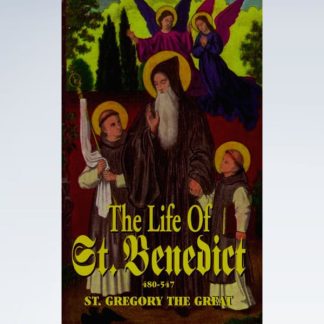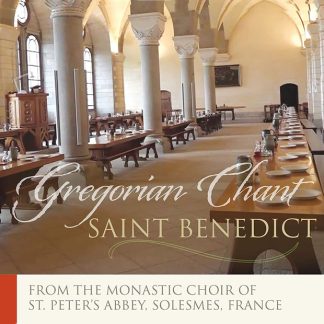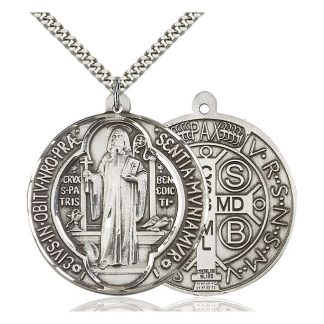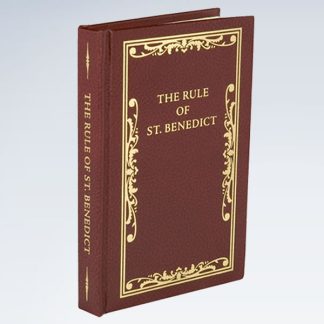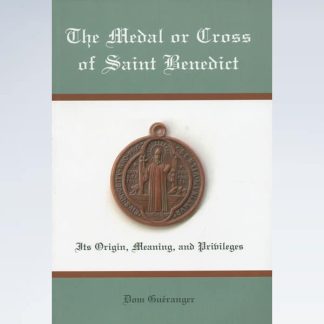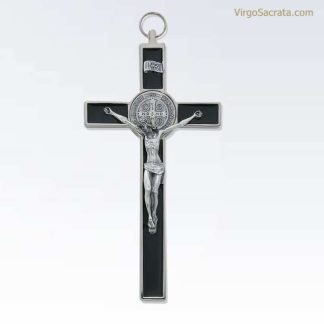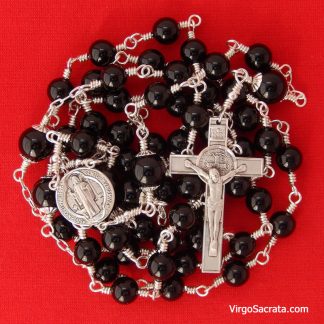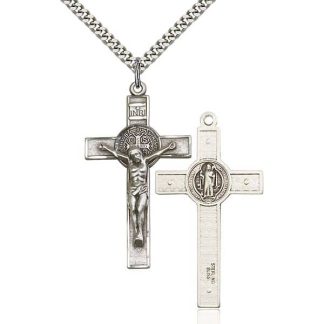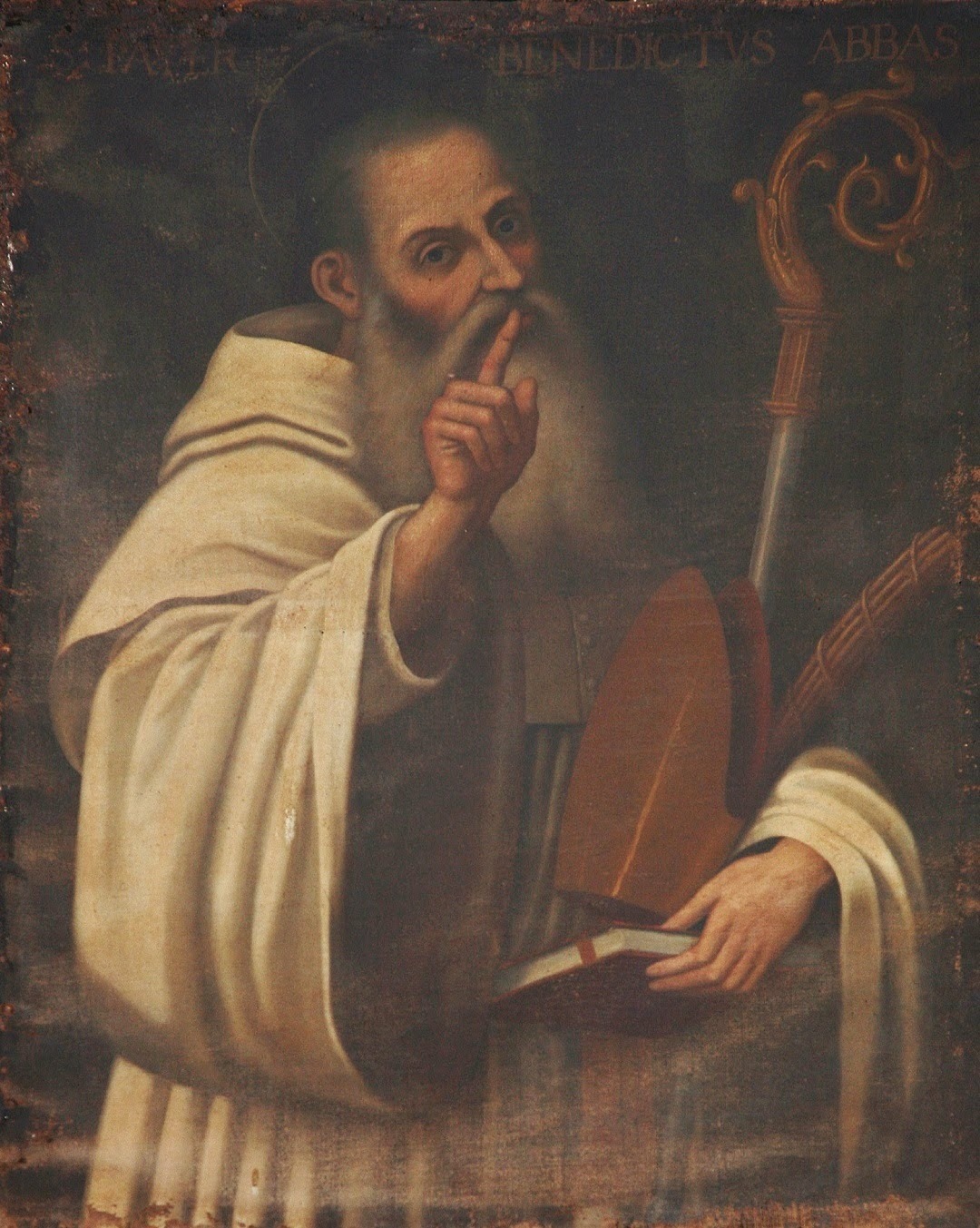
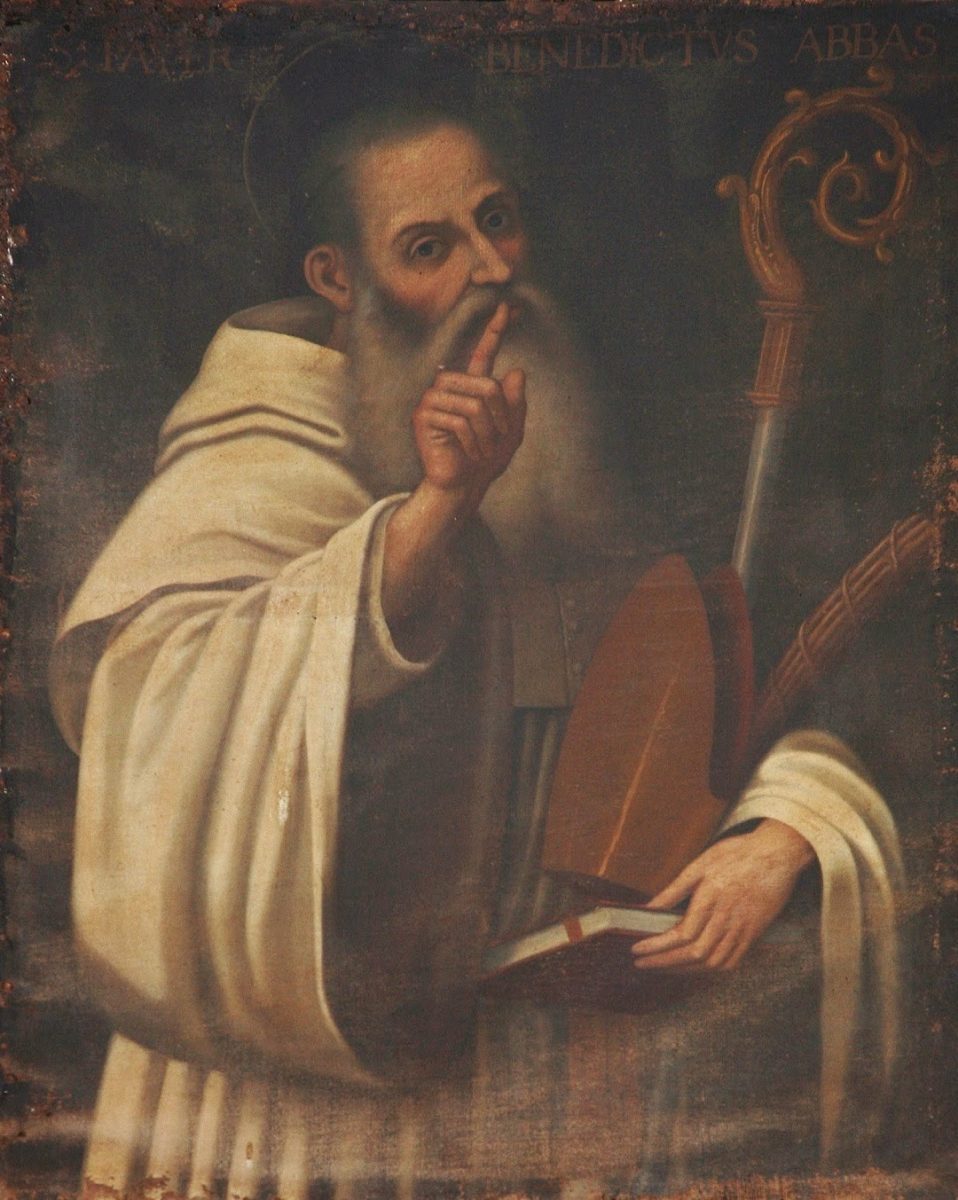
“Open thou mine eyes: and I will consider the wondrous things of thy law.”
Ps. 119:18
At very turning of history God raises great saints in order to strengthen the supernatural hold over souls exercised by the Church in virtue of her divine mission. The Roman Empire had crumbled down and the Barbarian has invaded whole Europe. Then appeared Benedict as chief of the monks of the West.
Benedict was born in central Italy, about the year 480, when the civilized world was being overrun by pagan and heretical tribes. As a young man, he withdrew to the mountainous region of Subiaco to live there as a hermit. Soon many disciples followed him. Later, St. Benedict left Subiaco for Monte Cassino and founded on its summit a monastery that became the most famous in Europe. After having rescued Europe from the darkness and ignorance that followed the downfall of the Roman Empire, St. Benedict’s monks went out into the whole world to combat paganism with the light of Christ.
They were the great civilizers, and their influence upon subsequent history is incalculable. Even more importantly, the spirituality of Western Christianity has been shaped by the famous Rule Benedict devised for his monks. With this Rule he provided a “school of the Lord’s service” which embraced a program of liturgical prayer, sacred study, and work, lived socially in community under one common father, with noticeable emphasis on peace, moderation (especially as regards austerities), and charity towards all men.
St. Benedicts’ Great Miracles
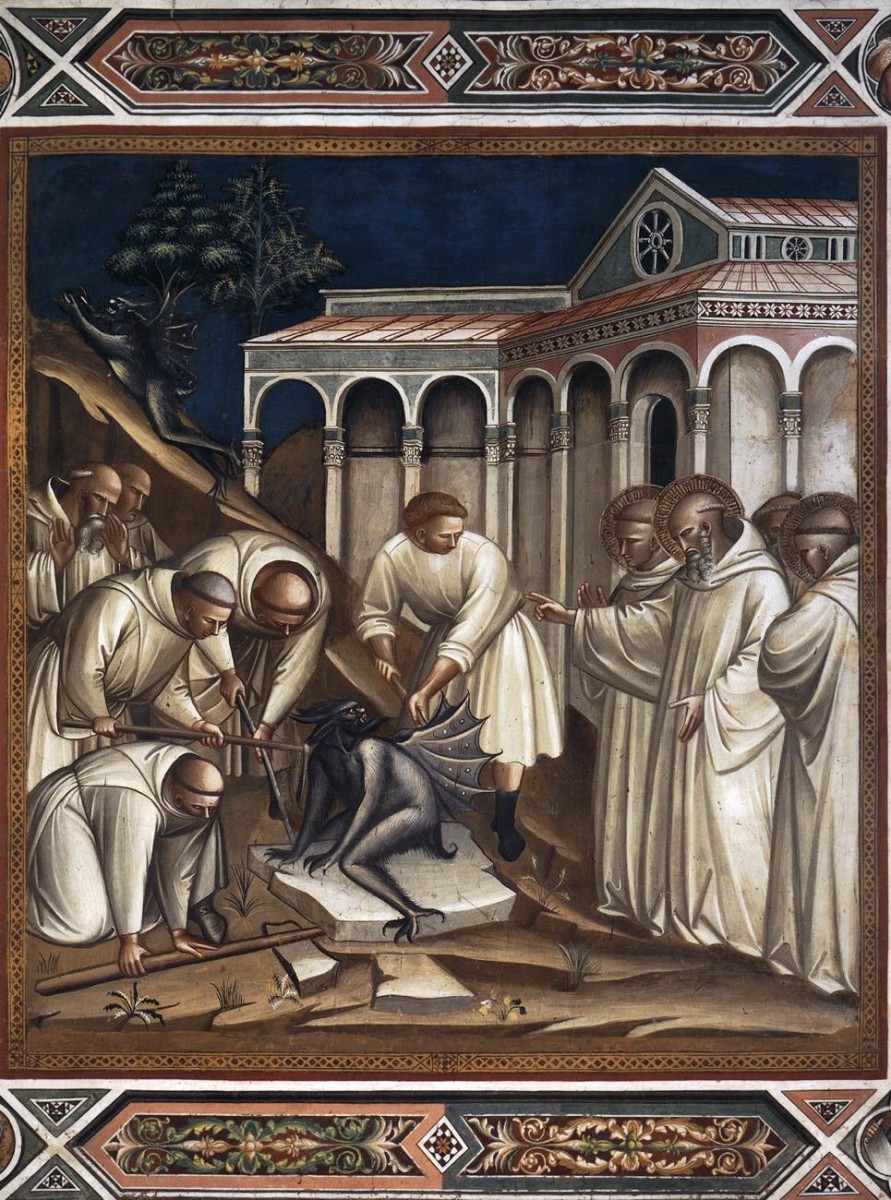
As Christianity spreads during the Dark Ages, St. Benedict gains a reputation for performing great miracles and also levying strict discipline. The thirty-eight short chapters of the The Life of Our most Holy Father St-Benedict by St. Gregory the Great, contain accounts of Benedict’s life and miracles. Some chapters recount his ability to read other persons’ minds; other chapters tell of his miraculous works, e.g., making water flow from rocks, sending a disciple to walk on the water, making oil continue to flow from a flask. St Benedict’s prayer enables the monks to lift the stone on which the devil is sitting. That’s the power of St-Benedict prayer for you.
“And Jesus answering, saith to them: Have the faith of God. Amen I say to you, that whosoever shall say to this mountain, Be thou removed and be cast into the sea, and shall not stagger in his heart, but believe, that whatsoever he saith shall be done; it shall be done unto him. Therefore I say unto you, all things, whatsoever you ask when ye pray, believe that you shall receive; and they shall come unto you. And when you shall stand to pray, forgive, if you have aught against any man; that your Father also, who is in heaven, may forgive you your sins. But if you will not forgive, neither will your Father that is in heaven, forgive you your sins.” Mark 11:22-26.
The miracle stories echo the events of certain prophets of Israel as well as happenings in the life of Jesus. The message is clear: Benedict’s holiness mirrors the saints and prophets of old and God has not abandoned his people; he continues to bless them with holy persons.
According to the Traditional Liturgical Calendar, the St-Benedict feast is celebrated on March 21st, two days after the feast of St. Joseph.
About the Original Medal of St. Benedict
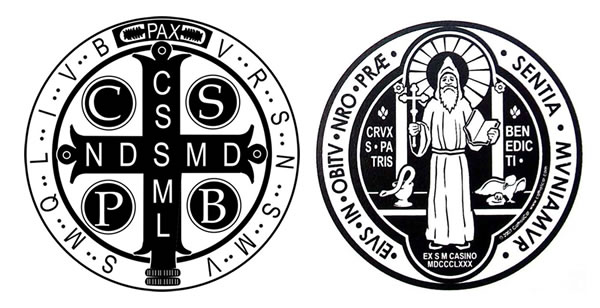
This highly indulgenced medal bears a likeness of the great “Father of the Monastic Life.” In his right hand is a cross, beside which are the words Crux “Patris Benedicti” (“The Cross of the Father Benedict”); in his left hand is the book of the Benedictine rule. At his feet are represented a chalice and a raven, symbols of the priesthood and of hermit life. Around the edge are the words “Eius in Obitu Nostro Praesentia Muniamur” (“At our death may we be fortified by His presence”).
On the reverse side is a cross, on the vertical bar of which are the initial letters of the words “Crux Sacra Sit Mihi Lux” (“The holy Cross be my light”); on the horizontal bar are the initials of “Non Draco Sit Mihi Dux” (“Let not the Dragon be my guide”); and around are other letters signifying other Latin mottoes. At the top is usually the word “Pax” (“Peace”) or the monogram “I H S.” The Benedictine medal in its present form commemorates the 1400th anniversary of the birth of St. Benedict, celebrated in 1880. The right to make it is reserved exclusively to the Great Archabbey of Monte Cassino, in Italy.
There are many indulgences for the wearers, including a plenary one on All Souls’ Day, obtained by visiting a church on that day or on its eve, and praying there for the intention of the Holy Father. The original medal of St. Benedict was first approved by Benedict XIV in 1741, and further indulgences were granted by Pius IX in 1877 and by St Pius X in 1907.
The Use of the St. Benedict Medal
It may be worn about the neck, attached to the scapular or the rosary, or otherwise carried devoutly about one’s person. For the sick it can be placed on wounds, dipped in medicine or in water which is given to them to drink.
The St-Benedict Medals and Tokens are frequently put into the foundation of houses or in walls, hung over doors, or fastened on stables and barns to call down God’s protection and blessing. It is also buried in fields, as the saintly Father Paul of Moll advised his friends to do.
Blessing Ritual of the St. Benedict Medal includes the Exorcism Formula. Catholics should seek the traditional catholic priest who will humbly pray to God for all the blessings. The very wearing and use of such Medal is considered a continues silent prayer to God to grant us, through the merits of St. Benedict, peace, protection, and the favors we request.
For obtaining extraordinary favors, it is highly recommended to perform special devotions in honor of the holy Father St. Benedict such as reading (and following) St Benedict rules, attending the Most Holy Sacrifice of the Mass on St. Benedict Feast Day (March 21st), and praying novena to St. Benedict.
St-Benedict Prayer
May the intercession of the Blessed Patriarch and Abbot Benedict render Thee merciful unto us, O Lord, that what our own unworthiness cannot obtain, we may receive through his powerful patronage. Through Christ Our Lord. Amen.
(The St-Benedict prayer may be said when using the Medal for any pious purpose.)
Novena Prayer to St. Benedict
O glorious St. Benedict, sublime model of virtue, pure vessel of God’s grace! Behold me humbly kneeling at thy feet. I implore thee, in thy loving kindness, to pray for me before the throne of God. To thee do I have recourse in the dangers that daily surround me. Shield me against my selfishness and my indifference to God and to my neighbor. Inspire me to imitate thee in all things. May thy blessing be with me always, so that I may see and serve Christ in others and work for His kingdom.
Graciously obtain for me from God these favors and graces which I need so much in the trials, miseries and afflictions of life. Thy heart was always full of love, compassion and mercy toward those who were afflicted or troubled in any way. Thou didst never dismiss without consolation and assistance anyone who had recourse to thee. I therefore invoke thy powerful intercession, confident in the hope that thou wilt hear my prayers and obtain for me the special grace and favor I earnestly implore. (Name your petition.)
Help me, great St. Benedict, to live and die as a faithful child of God, to run in the sweetness of His loving will and to attain the eternal happiness of Heaven. Amen.

For literature on St Benedict, as well as prayer books, and other devotional items such as St Benedict Medals, Benedictine Holy Coin Tokens, the Crucifix of Saint Benedict, and St-Benedict Rosaries, please visit Virgo Sacrata shop online.
-
The Life of St. Benedict (480-547) by Pope St. Gregory the GreatUS$ 10.00
-
Saint Benedict – Gregorian Chant CDUS$ 22.00
-
St Benedict Medal Pendant 1 5/8″US$ 240.00 – US$ 10,700.00
-
The Rule of Saint BenedictUS$ 24.00
-
The Medal or Cross of St. BenedictUS$ 19.00
-
St Benedict Black Epoxy Wall Crucifix 8″US$ 60.00
-
Sterling Silver Saint Benedict RosaryUS$ 330.00
-
The Rule of Saint BenedictUS$ 24.00
-
St-Benedict Crucifix Pendant 1 3/4″US$ 109.00 – US$ 3,419.00
VIRGÓ SACRÁTA is a Christian mission-driven online resource and shop inspired from the beauty of Catholic faith, tradition, and arts. Our mission is to “Restore All Things to Christ!”, in continuing the legacy of Pope St. Pius X under the patronage of the Blessed Virgin Mary. “Who is she that cometh forth as the morning rising, fair as the moon, bright as the sun, terrible as an army set in battle array?” O Mary, conceived without sin, pray for us who have recourse to Thee.

